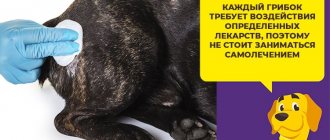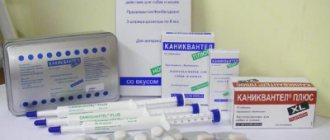How to determine if a dog has ear mites How to treat otodectosis How to prevent otodectosis in a dog
Otodectosis
or
ear mites
is one of the most common parasitic diseases in domestic animals; it is somewhat less common in dogs than in cats, but is also a very common problem. This disease is caused by microscopic mites Otodectes cynotis, which infect the area of the external auditory canal and pinna.
Pathogen and routes of infection
The cause of the development of otodectosis is the microscopic parasite Otodectes cynotis. It is so small (0.2-0.5 mm) that it is difficult to detect with the naked eye.
The pathogen leaves visible traces of its vital activity in the form of dust particles-feces.
The favorite habitat of arthropods is a moist, warm environment. They find it in the ear cavities of animals, where there are suitable conditions for a comfortable existence.
The tick's favorite areas for settlement are the inner wall of the shell and the ear canal, where there is everything for the parasite to feed on - the epidermis, particles of sulfur and the blood of the animal.
Most often, the infection occurs in pets who walk outside and come into contact with infected animals. But even decorative apartment breeds of dogs can pick up ear mites through household items (dishes, bed, collar, slicker, etc.).
The pathogen can also be brought into the house by people on clothes or shoes, and small puppies can get ear scabies from their sick mother.
A tick can exist outside the animal’s body for a long time. Infection may not occur immediately .
To get to a suitable place, the mobile parasite only needs to get to any part of the body and from there move to the ear.
How is diagnosis carried out?
Ear mites in dogs can only be detected by laboratory testing of discharge taken from the ear.
Using a clean ear stick, as much of the brown contents as possible are collected from the ear of the quadruped and applied to a laboratory glass. Cover it with another piece of glass and look under a microscope. If the dog really has an ear parasite, then under a microscope the doctor will easily see how the little reptiles scurry back and forth. After confirming the diagnosis, the doctor prescribes treatment.
Treatment is carried out with special drugs. Medicines are prescribed depending on the degree of development of the sore. You won’t be able to get rid of the harmful bloodsucker instantly. Therefore, you should gain strength and act strictly in accordance with the instructions for the medications and the doctor’s recommendations.
Before you begin the treatment itself, you need to thoroughly clean your pet’s ears of all contaminants: accumulated wax, crusts and parasite waste.
To do this, you need to take a piece of bandage or a cotton pad. Moisten the disc in a solution of furatsilin, chlorhexidine, boric acid or hydrogen peroxide and carefully remove all secretions. In the version with peroxide, do not allow the solution to get directly into the ear.
Or purchase special hygiene lotions for cleaning the ears at the animal pharmacy, for example: Epi-otik or Otodin. In addition to the fact that these lotions are good at removing scabs and removing unpleasant odors, they can also be used as a prophylactic drug even for a healthy animal.
If necessary, perform the cleaning procedure several times.
Important! You cannot use one cotton pad to clean both ears at once.
For the treatment of otodectosis, medications are usually prescribed in the form of drops. Among the most famous are: Tsipam, Amitrazin, Aurikan, Anandin, Otovedin, Dekta, Bars.
Important! Treatment must be carried out strictly in accordance with the instructions. All drugs must be administered into both ears, even if otodectosis affects only one.
In case of otodectosis complicated by bacterial or fungal infections, the following medicinal ointments and gels are prescribed for external treatment of the ears and other parts of the animal’s body: Amidel-gel, Aversectin ointment, Oridermil, Sulfur ointment.
If after treatment the parasite has not disappeared, it means that you did not follow all the doctor’s instructions and did not act strictly according to the instructions for the drug prescribed by the doctor, or your dog has very low immunity.
For a speedy recovery of your beloved little ear, in this, and in other cases, vitamin complexes will be very helpful. Provide your fluffy with comfortable living conditions. Carry out hygienic cleaning of the apartment, toys and pet's sleeping place more often.
Introduce more vegetables, fruits, and fresh meat into your diet. To strengthen the immune system, fish oil helps a lot, which can be given to your pet not only during illness, but also throughout its life.
Important! If at least one pet in the house is sick, it is necessary to pay due attention to all four-legged household members.
How to determine if a dog has otodectosis
Most often, young individuals suffer from ear scabies. In adult pets, infection can be asymptomatic: the dog may not be sick, but be a source of infection.
The first symptom - scratching behind the ear - is already considered the first sign of the disease.
Dog owners should carefully inspect their pet's ears, inside and out. If infection is present, the skin will be scratched until it bleeds.
The stronger the itching, the more aggressive the pet's actions. It is no longer possible to relieve the discomfort with its paws alone, and the dog has to rub its ears against furniture and other hard objects, further injuring the dermis.
As a result, inflammatory processes begin, turning into a purulent stage and accompanied by an unpleasant odor.
Trying to get rid of parasites, the dog vigorously shakes its head. But this does not help - the tick becomes firmly attached inside the ear. Out of helplessness, the animal begins to whine pitifully, asking for help from the owner, but at the same time does not allow him to touch his ears.
Disease prevention
Preventive measures aimed at preventing a pet from getting ear mites are simple and accessible to every four-legged owner. By doing them, you will protect your beloved furry from suffering.
Here are some recommendations:
- Inspect your four-legged ears frequently for any discharge.
- If, as a result of the examination, you notice black and brown dirt, take your dog to a specialist, since dark discharge is not always a sign of ear mites in dogs. With a thorough examination and testing, the doctor will make an accurate diagnosis.
- Systematically carry out preventive ear cleaning with special drops and lotions.
- Protect your pet from contact with stray dogs.
- Use special insecticidal modern products to protect against parasites. Choose products with caution, as certain drugs present in them can cause severe allergic reactions in the animal.
Although the risk of ear mites in dogs is high, do not deprive your beloved dog of the pleasure of running on fresh grass and chatting with familiar dogs.
With proper care, regular preventive measures, and timely contact with a veterinarian, in case of infection, parasites will not cause serious harm. In the early stages, otodectosis can be cured fairly quickly.
Good luck and take care of your pets!
Ear mites, or scientifically called otodectosis, often affects our dogs and gives them a lot of unpleasant sensations. People call this disease ear scabies, and for good reason, because the disease is provoked by a parasite that is localized in the animal’s ears, causing it to behave unusually. What kind of disease is this, how can it be recognized and, most importantly, get rid of it in a timely manner?
Where and how is it diagnosed?
Even if you notice alarming signs in your pet and find “coffee dust” (traces of mite activity) in the ear canal, you should not begin self-medication.
Incorrectly selected therapy will lead to deafness of the pet and more serious consequences.
The first action of a dog owner is to visit a veterinarian who examines the animal. To begin with, the doctor will study the nature of the primary symptoms, and only then prescribe a course of therapy.
Primary signs of otodectosis
| Symptom | Peculiarities |
| Itching | This is the main indicator of ear infection. Symptoms become a reaction to the feces and saliva of the arthropod parasite. At the initial stage, the itching is mild, then it intensifies due to developing inflammation. |
| Ear discharge | First, a serous, clear exudate oozes from the dog's ear canal. Then impurities of pus appear in it, due to which the discharge becomes fetid |
The nature of the primary symptoms allows the specialist to determine at what stage the disease is. To confirm the diagnosis, a swab is taken from the outer ear of dogs to examine it for microflora.
The doctor evaluates both the degree of alopecia in the ear area and the animal’s pain sensitivity. By the angle of the head, you can judge the amount of exudate accumulated in the ear.
Sometimes there are no obvious symptoms of otodectosis, and owners stop treating their pet (or ignore it altogether).
As a result, the inflammatory process can go inside, behind the middle ear. Then the exudate will not leak out, but will enter the brain and cause the death of the animal.
Characteristic symptoms of the disease
It is not difficult to notice otodectosis, but it is important to distinguish it from demodicosis. In the latter case, the demodex mite “spreads” throughout the body, forming characteristic inflamed lesions. Ear mites are found only on the inner surface of the ear and inside the auricle.
Ear mites on a dog
Symptoms of an invasive disease:
- swelling on the inner surface of the ear;
- diffuse redness of the skin;
- dark brown oily coating, a waste product of ear mites, wax, dead particles of the dermis;
- the addition of secondary microflora and the lack of treatment for otodectosis in a dog provokes the transition of the pathological process to the inner ear and meninges.
The pet's behavior changes. A characteristic posture is tilting the head towards the ear affected by otodectosis. Furious scratching, turning into intense shaking of the head. The animal seems to be trying to “scratch” the problem out of the ear.
In its advanced form, pus accumulates in the auricle, flowing out and sticking together the strands of hair on the lower edge. The smell is characteristic, heavy, unpleasant. When the meninges are damaged, nerve pathologies develop. At this stage, treatment of otodectosis is not always effective, and the dog dies.
Fact! Later treatment of ear scabies is almost always complicated by secondary infection, damage to the eardrum and deafness of the pet. Chronic otitis and meningitis are difficult to treat; the fine-grained substance from tick waste products is a paradise for fungi and bacteria!
Treatment of ear scabies in dogs
The main therapy for otodectosis is divided into stages, including a strictly defined procedure. It is not recommended to carry out procedures on your own at home.
Stage 1 – mechanical cleaning
The goal is to remove wax, scabs and crusts from the auricle.
The next stage, rinsing, depends on the quality of cleaning, so specialized preparations Auricap or Otomin are used.
They help flush out accumulations and relieve pain symptoms .
You can also use Bars lotion. Hydrogen peroxide is not advisable in this case - the hissing of the solution scares the animals.
It is not recommended to use cotton swabs. Discs are more suitable here.
First, the selected product is dripped into the ear and the shell is massaged at the base. It is important that the dog does not shake its head. Next, fold the cotton pad in half and clean all the folds of the sink and passage.
Stage 2 – destruction of ticks
When the dog’s ears are cleared of all excess, other drugs are used to not only eliminate the inflammation, but also expel the mites. The products are available in various forms and are used strictly according to the attached instructions.
Means for the treatment of otodectosis
| Form of the drug | Titles | Mode of application |
| Gels, ointments | Aversectin, Novertin Oridermil | The product is applied to the auricle (its inner part) with a cotton pad. |
| Ear drops | Amitrazine, Dekta-Forte, Surolan | Instill into the ear canal, trying to get the medicine into the middle ear |
| Spray | Ivermectin | Read the instructions carefully: there are forms for internal and external use |
| External drops | Lawyer, Stronghold, Fiprist Combo | Apply exclusively to the pet's withers |
| Injections | Ivermek | The animal is given an injection with a 1% antiparasitic solution |
You should not use all the means at once. The doctor will select the right drug. Aggressive dogs usually do not allow their ears to be buried. Therefore, they are treated with external agents or injections.
Note! Not only the infected ear should be treated, but also the healthy one to avoid infection.
Stage 3 – relief of complications
If the owner of the dog is attentive to its health, this step usually does not come to this. This stage is necessary in advanced situations when otodectosis has caused complications in the form of otitis media, an abscess, or is accompanied by other diseases.
Expert opinion
Panteleeva Irina Petrovna
Breeder, 11 years experience.
In each case, treatment is selected individually.
How to prepare your pet for procedures
Severe itching and painful symptoms are already stressful for the animal.
Therefore, any action to provide assistance can only frighten the dog. To avoid this, you need to act without haste, trying to calm your pet.
Some dogs have a positive effect on their favorite treat. Sometimes it is not possible to do without short-term euthanasia.
If left untreated
If treatment is delayed or completely ignored, the following serious complications may develop:
- otitis;
- ruptured eardrum;
- arachnoiditis;
- labyrinthitis;
- inflammation of the membranes of the brain.
Any of the consequences will not only result in the animal becoming deaf, but can also cause seizures and death.
Treatment
You should not treat otodectosis in your pet on your own. The treatment regimen is prescribed by the doctor. It takes into account the severity of the pathology, breed and individual characteristics of the dog.
The first step is to remove the waste products of parasites from the ear canals. This is done using cotton swabs and cleaning solutions. Next, the crusts are soaked and carefully removed. Veterinary pharmacies sell lotions for removing crusts. They are good because they have an antipruritic effect and eliminate unpleasant odor.
Once the ear canals are completely cleaned, medications are injected into them to kill the mites. Basically, these are special drops. They are always instilled into both ears, even if only one is affected.
List of ear drops:
- Leopard;
- Dana;
- Amit;
- Epacid-alpha;
- Aurikan;
- Demos;
- Otibiovin;
- Dekta;
- Surolan;
- Amitrizan plus;
- Ectodes;
- Otovedin.
There are also ointments, gels and injections.
List of medicinal ointments:
- sulfur-tar ointment;
- Oridermil;
- Aversectin;
- Vishnevsky's liniment.
Immediately before application, the ointment should be warmed to room temperature. It is rubbed in with massage movements so that the medicine penetrates deep into the epidermis.
Injections ─ Otodectin and Ivermec 1% are very effective. If there are no contraindications, then this method of treatment is optimal.
The above drugs help destroy adult parasites. After the first course, re-treatment should be carried out 1-2 weeks later.
All insecticidal products contain potent substances. They are dangerous, so it is important to follow strict application procedures and recommended dosages. To do this, you need to follow the instructions and take into account the weight of the animal.
Physiotherapeutic procedures and ear massage provide a good therapeutic effect. If the therapeutic course is completed completely, but ear scabies reappears, then the reason may be the animal’s reduced immunity.
Options for protecting your pet from ticks
It is worth keeping in mind that no veterinarian can guarantee a 100% cure for otodectosis if the dog’s owner does not take any protective measures.
Prevention includes:
- periodic cleaning of your pet's ears;
- avoiding contact with street animals;
- insectoacaricidal treatment of dogs in the warm season;
- keeping your pet's household items clean;
- regular cleaning of premises.
Expert opinion
Makarenko Svetlana Igorevna
Practicing veterinarian, 15 years of experience.
Having discovered the first signs of ear scabies, your pet should immediately be shown to a specialist. This will allow you to eliminate the problem in time, preventing it from becoming chronic.











